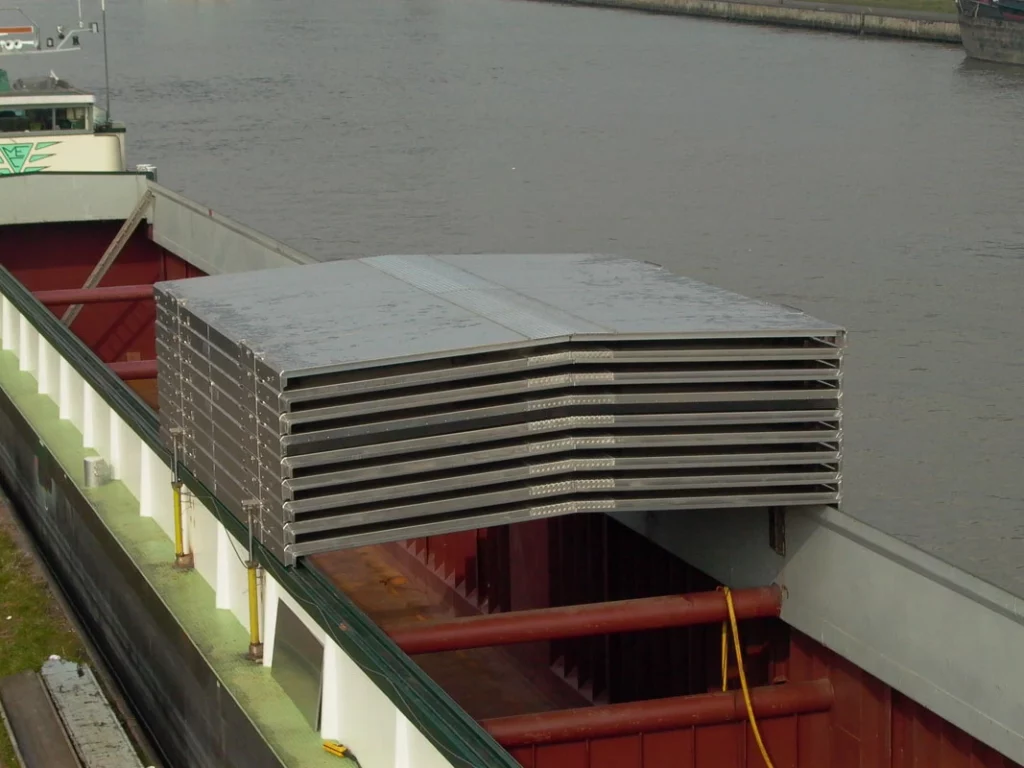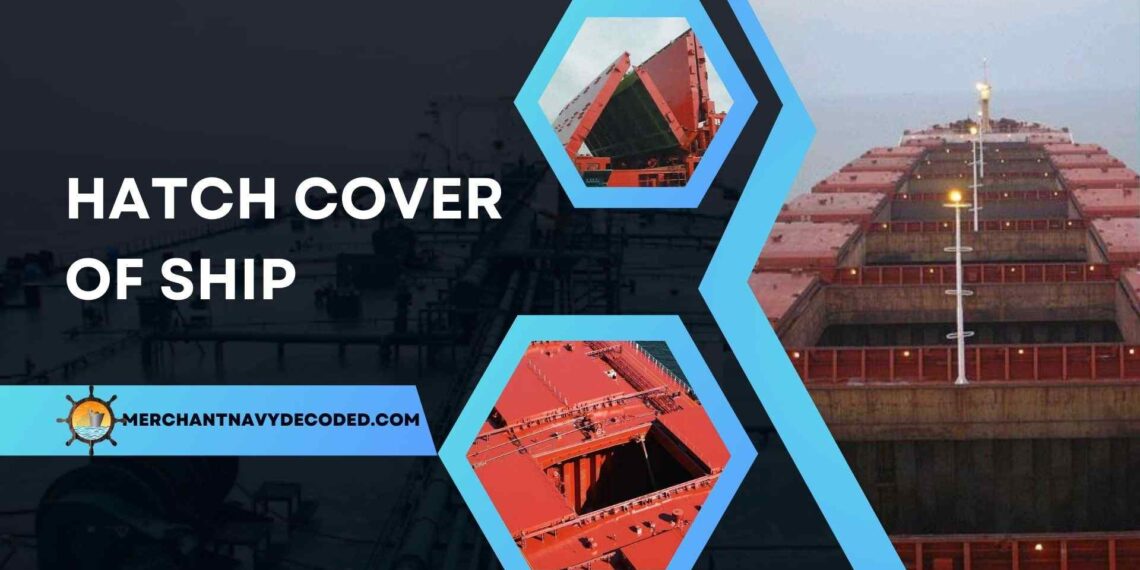Hatch of a Ship | A Complete Guide
Hatch covers are critical ship components that guarantee security and safety, respectively, for cargo and the vessel. In this case, the structures shield the holds of a ship from the marine environment on board and prevent water from penetrating these holds, which would destroy cargo on board and destabilize the ship.
1:- What are Hatch Covers?
Hatch covers are strong constructions that are intended to cover openings of cargo holds aboard a ship. Being a critical component in the watertight integrity of a ship, it protects cargo from seawater, rain, and other environmental factors. A well-functioning hatch cover means safe and efficient operation of any cargo-carrying vessel.
2:- Structure of a Hatch Cover on a Ship
The structure of a hatch cover typically includes the following components:
Top Plate: The outermost covering that comes into direct contact with an external environment. Normally, it is fabricated from steel or aluminum to withstand adverse conditions.
Beams and Girders: Provided to support the hatch covers structurally to enable carrying cargo and to withstand pressures external to the cover.
Sealing System: Rubber gaskets or seals are applied on the periphery of a hatch cover with the seal being watertight.
Cleats and Wedges: The system is fitted around the hatch to ensure that it is sealed tightly.
Drain Channels: These channels are drained along the edges to guide the water away from the cargo space.
3:- Hatch Cover Types Used on Ships
Following are the different types of hatch covers used on ships:
3.1:- Lifting Type Hatch Covers

Lifting-type hatch covers consist of single-panel covers and multi-panel covers. They are also called McGregor-type Hatch Cover, named after its inventor and now manufacturers as well.
Single Panel Covers:
- It is broadly used on bulk carriers.
- It consists of one big cover per cargo hold.
Multi-Panel Covers:
- Used on container ships and multi-purpose vessels.
- It consists of several small panels, which can be opened individually.
Method of Operation:
- These are operated by cranes or derricks. The covers are lifted vertically out of the cargo hold and set aside, thereby leaving large, open apertures.
3.2:- Rolling Type Hatch Covers

Structure:
- Large panels mounted on wheels.
- Wheels run on tracks laid on the deck.
Method of Operation:
- Panels roll horizontally, typically hydraulically powered due to their size.
- Rolling is facilitated by pulleys to prevent vertical and horizontal movement during operation.
- Used for easy and controlled movement, making them suitable for large openings on general cargo ships and some bulk carriers.
3.3:- Folding Type Hatch Covers

Structure:
- Panels are hinged together in sets of two or more.
- Hydraulic systems facilitate their movement.
Method of Operation:
- Panels fold upwards and stack upon each other.
- The folding mechanism allows for quick and efficient operation.
- Commonly used on general cargo ships and for weather decks.
3.4:- Sliding Type Hatch Covers

Structure:
- Panels slide either longitudinally (along the ship’s length) or transversely (across the ship’s width).
Method of Operation:
- Operated using manual or hydraulic power.
- Panels slide to open and close, providing efficient access to the cargo hold.
- Commonly used on large dry bulk carriers due to their simplicity and ease of use.
4:- Are Hatch Covers Water-Tight or Weather-Tight?
Hatch covers on ships are designed to be weathertight, preventing water ingress under normal weather conditions. This weather tightness is crucial for protecting cargo from water damage, preserving its quality, and maintaining the ship’s stability.
Structural integrity and weather tightness ensure vessel safety, preventing corrosion and weakening of internal structures. Compliance with maritime regulations avoids penalties and costly delays, while proper maintenance reduces repair costs and insurance claims.
Additionally, maintaining weathertight hatch covers enhances crew safety by preventing slippery conditions and ensuring the vessel remains seaworthy in emergencies.
5:- Importance of Compression Bars and Sealing Gaskets
Compression bars and sealing gaskets are important features to ensure that hatch covers aboard ships are weather-tight. Compression bars ensure that an adequate seal is made by compressing the gasket into the coaming, thus making water-proof provisions against entry of water when seas become very rough.
Gaskets must be kept in good condition; otherwise, leaks are bound to occur. It is necessary that the gaskets are inspected regularly for their effectiveness and that they are replaced in time so as not to compromise the purpose that a given compression bar renders.
In addition, the compression bars should not show any appearance of rust and should be well-centered for an effective seal of shipment. Neglect of these items would result in major damages to cargo coupled with safety issues
6:- Methods of Testing Weather Tightness of Hatch Cover
This calls for extreme tests to determine whether the hatch cover is effective or not. Anything that might start as a defect must be discovered and corrected before it becomes an important flaw.
6.1:- Visual Inspection
- Check for Damages: Examine the hatch cover and all its components for any cracks or corrosion caused by weather conditions.
- Sealing Condition: Rubber seals should be in good condition, showing no signs of deterioration or damage. They should be complete and thus capable of forming a watertight seal.
6.2:- Water Hose Test
Hose Test: Under pressure, a water hose is sprayed along the joints and edges of the hatch cover. Observe for any leakage; thereby, identifying regions where the seal may be weakened.
6.3:- Ultrasonic Test
Ultrasonic Tester: In this method, an ultrasonic tester is used to detect leakage. This tool sends sound waves through the hatch cover. Any rupture in the wave indicates leakage.
Accuracy: Ultrasound testing is accurate to the last leak that may not be detected by a visual inspection or a hose test.
6.4:- Chalk Testing
Application of Chalk: Chalk is applied to sealing surfaces of the hatch cover. Once the cover has closed, chalk transfer should be even, which would indicate the seal is good. Any gap in chalk transfer may indicate problem areas.
7:- Precautions While Operating Hatch Covers
Precautions onboard ships are endless. There are dedicated checklists to cover the safety aspects while operating hatch covers. However, here are some of the most important ones. Remember, the list is non-exhaustive:
1. Clear Environment: The area around the hatch cover must be vacated from obstructions as well as personnel.
2. Apparatus Tests: Hatch covers, moving parts, seals, and securing devices must be tested for any damage or wear.
3. Personal Protective Gear: To be used, appropriate personal protective equipment, including a hard hat, safety shoes, gloves, and high-visibility clothing, must be worn by the crew.
4. Communication: Specific signals must be created and personnel concerned must be informed to conduct the hatch covers safely.
5. Procedural Precautions: Hatch covers shall be operated according to the manufacturer’s operating instructions and equipment.
6. Weather Consideration: Hatch covers shall not be operated in wind speed above 45 knots, in heavy rain, and when the ship experiences rough seas.
7. Hydraulic System Inspection: Check for hydraulic fluid levels and inspect for leaks.
8. Electrical Precaution: Ensure there is a steady power source and switch it off when doing maintenance work.
9. Tying Up Properly: Ensure hatch covers are properly lashed closed with cleats, wedges, or other tying-up devices.
10. Routine Maintenance: Establish a routine maintenance schedule that will keep all inspections and repairs fully documented.
8:- Conclusion
Hatch covers are one of the critical components of a ship since they offer a layer of protection for cargo and, therefore, fit into the integrity of the vessel. Familiarity with its designs, application, and testing procedures is intended to ensure their functionality and reliability.
Disclaimer :- The opinions expressed in this article belong solely to the author and may not necessarily reflect those of Merchant Navy Decoded. We cannot guarantee the accuracy of the information provided and disclaim any responsibility for it. Data and visuals used are sourced from publicly available information and may not be authenticated by any regulatory body. Reviews and comments appearing on our blogs represent the opinions of individuals and do not necessarily reflect the views of Merchant Navy Decoded. We are not responsible for any loss or damage resulting from reliance on these reviews or comments.
Reproduction, copying, sharing, or use of the article or images in any form is strictly prohibited without prior permission from both the author and Merchant Navy Decoded.




